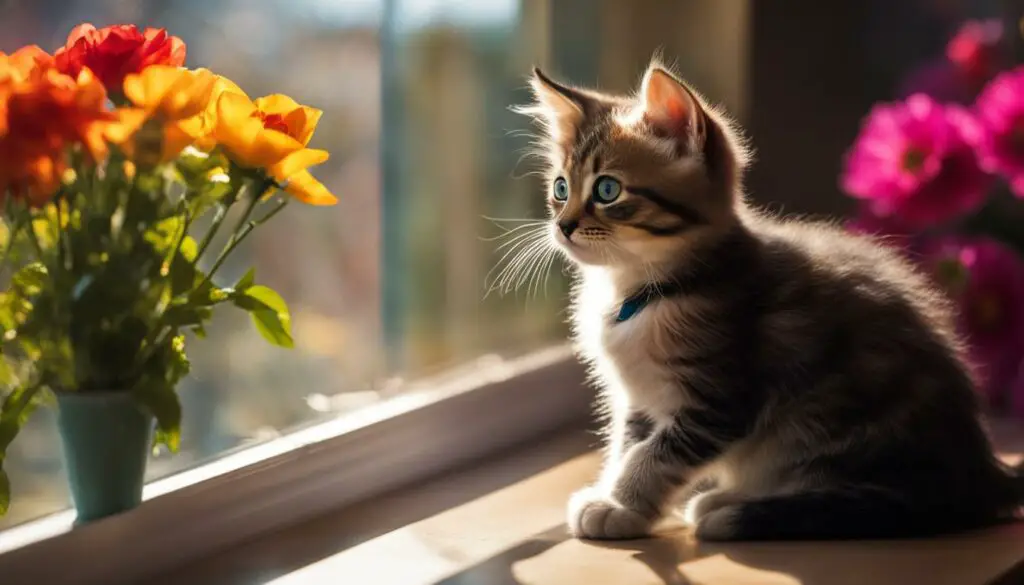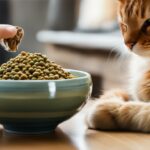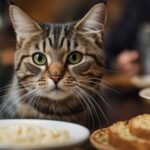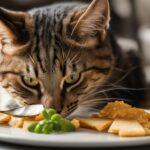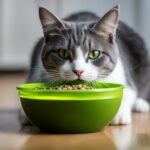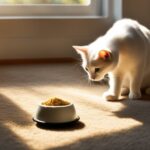Greetings, feline enthusiasts! Today, I want to delve into the intriguing behavior of affection eating in cats. Have you ever wondered why your furry friend insists on munching away in your presence? Well, prepare to be enlightened.
Affection eating is a unique behavior exhibited by cats, where they consume their food while basking in the company of their beloved humans. It’s their way of expressing love, affection, and contentment towards their human companions. Isn’t that just purrfect?
So, why do cats engage in affection eating? It’s simple – they adore you! By dining in your presence, they form a stronger bond with you, further solidifying their happiness and devotion. It’s their way of saying, “I love you, and I feel safe and secure by your side.”
Key Takeaways:
- Affection eating is a behavior in which cats eat in the presence of their favorite humans as a way to express love and strengthen the bond.
- Understanding affection eating helps cat owners provide a balanced and nutritious diet that meets their cat’s needs.
- Affection has several benefits for cats, including stress reduction and enhanced overall well-being.
- By encouraging affection eating, cat owners can deepen their bond with their feline friends.
- It’s important to be aware of any changes in your cat’s eating habits and consult a veterinarian if concerned.
Understanding Affection Eating in Cats
Affection eating is not just a sign of love; it also has implications for a cat’s nutrition and feeding habits. It is important for cat owners to provide a balanced and nutritious diet that meets their cat’s dietary needs. The choice of cat food, portion sizes, and mealtime routine all play a role in promoting a healthy eating habit in cats.
Cat nutrition is a crucial aspect of their overall well-being. Cats are obligate carnivores, which means they require a diet rich in animal protein. It is important to choose high-quality cat food that provides the necessary nutrients to support their growth, development, and overall health. Cats also have specific dietary requirements, including the need for taurine, an amino acid that is essential for their heart and eye health.
When it comes to feline feeding, portion control is key. Overfeeding can lead to obesity and other health issues, while underfeeding can result in nutrient deficiencies. It is important to follow the feeding guidelines provided by the cat food manufacturer and adjust portion sizes based on your cat’s individual needs. Regular veterinary check-ups can help ensure your cat maintains a healthy weight and receives the appropriate amount of food.
Establishing a consistent mealtime routine is beneficial for cats. Cats are creatures of habit, and they thrive on routine. By feeding your cat at the same time each day, you provide them with a sense of security and predictability. This can help reduce stress and anxiety and promote healthy eating habits. Additionally, creating a calm and comfortable environment during mealtime can further enhance the bond between you and your cat.
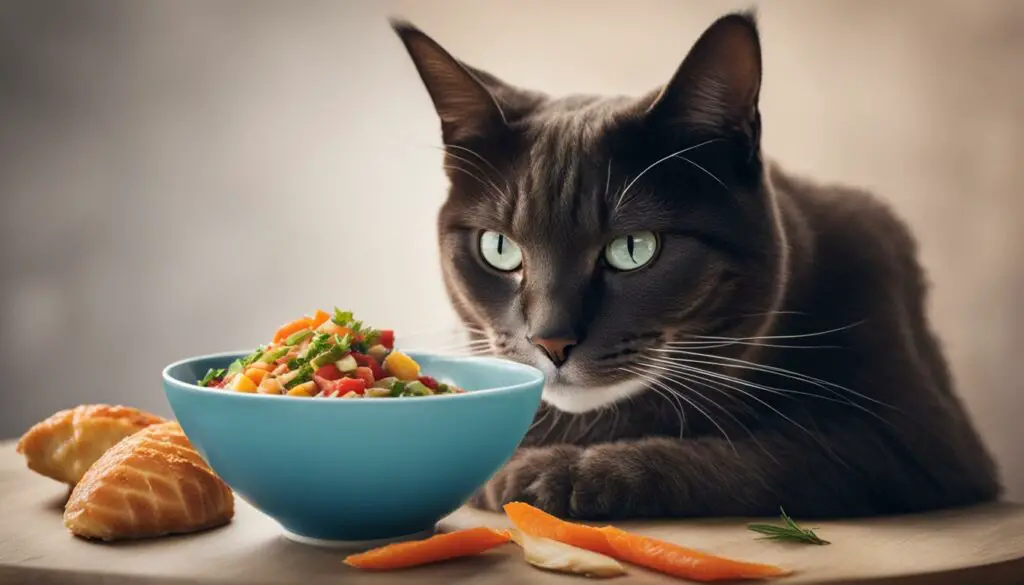
The Importance of Cat Food Choices
The choice of cat food plays a significant role in a cat’s overall nutrition. There are various options available, including dry kibble, wet canned food, and raw diets. It is important to choose a cat food that is appropriate for your cat’s age, health condition, and personal preferences.
Dry kibble is a popular choice for many cat owners due to its convenience and affordable price. However, it is important to note that dry cat food typically has a higher carbohydrate content compared to wet or raw diets. Cats have a limited ability to digest carbohydrates, and a diet high in carbohydrates can lead to weight gain and other health issues.
Wet canned food, on the other hand, has a higher moisture content and is closer to a cat’s natural diet. It can be beneficial for cats with urinary tract issues or those who do not drink enough water. However, it can be more expensive and may require refrigeration after opening.
Raw diets, which consist of uncooked meat and organs, are gaining popularity among some cat owners. Proponents of raw diets argue that they mimic a cat’s natural diet and provide optimal nutrition. However, it is important to consult with a veterinarian before transitioning your cat to a raw diet, as it can pose risks such as bacterial contamination.
The Benefits of Affection for Cats
Affection eating, the behavior where cats eat in the presence of their favorite human as a form of showing love and affection, offers numerous benefits for feline well-being. Showing love and affection to cats not only strengthens the bond between cat and owner but also reduces stress levels, promotes a sense of security, and enhances overall happiness.
Studies have shown that when cats receive love and affection from their human companions, their stress levels decrease significantly. This can have a positive impact on their mental and physical health, as stress can lead to various behavioral and health issues in cats. By showering cats with love and attention, owners can create a nurturing environment that helps their feline friends thrive.
The bond between cats and their owners is strengthened through affection. Cats are social animals that enjoy the company of their human companions. When owners show love and affection to their cats, it fosters a sense of trust, companionship, and mutual affection. This bond not only enhances the quality of the cat’s life but also brings joy and fulfillment to the owner.
Furthermore, affection eating provides cats with a sense of security and happiness. When a cat is surrounded by love and care during mealtime, it creates a positive association with food, making the cat feel safe and content. This can improve their overall eating habits and promote a healthy relationship with food.
It is important for cat owners to recognize the significance of affection in their cat’s life. By showing love and affection to cats, owners can provide a nurturing environment that not only enhances their well-being but also strengthens the bond between cat and owner. So, let your love and affection flow freely, and watch your cat thrive!
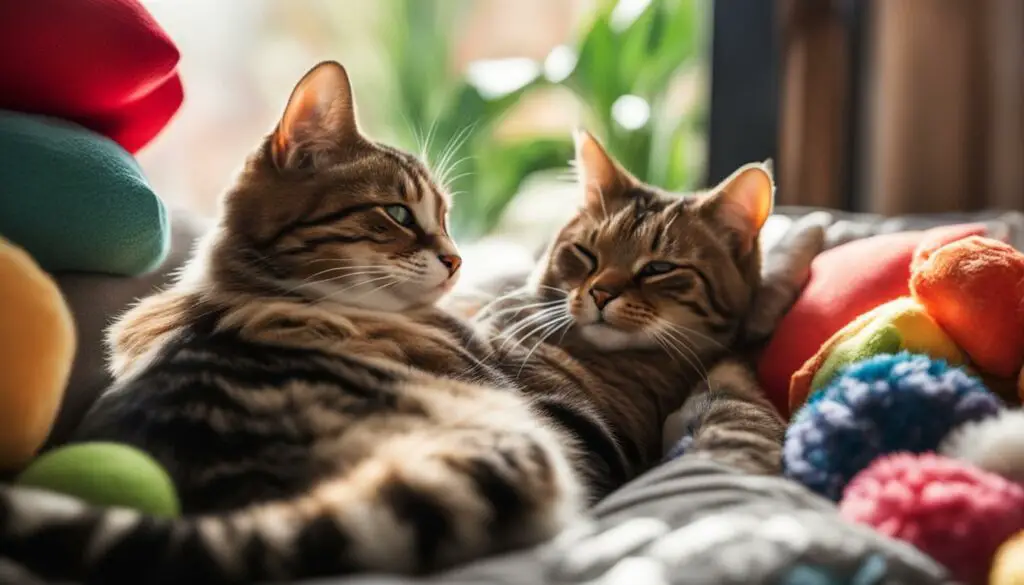
Understanding Cat Behavior
Understanding cat behavior is essential for cat owners to provide a nurturing and fulfilling environment for their feline companions. Cats have their unique ways of communicating and expressing themselves, and one fascinating behavior is affection eating. This behavior involves cats eating in the presence of their favorite human as a way to show love and strengthen the bond between them.
Cat behavior is a complex subject, and it encompasses various forms of communication. Cats communicate through body language, vocalizations, scent marking, and behaviors like purring, kneading, and head bunting. Affection eating is another behavior that cats use to express their love and affection towards their human companions.
This behavior can be traced back to the evolutionary instincts of cats. In the wild, cats would bring food to their kittens to teach them how to hunt and to bond with them. Affection eating in domesticated cats is believed to be an extension of this behavior, as they associate the act of eating with positive emotions and use it as a way to strengthen their bond with their favorite human.
| Common Cat Behaviors | Description |
|---|---|
| Purring | Purring is often associated with contentment and relaxation. Cats may purr when they are being petted or when they are in a comfortable and secure environment. |
| Kneading | Kneading is a behavior where cats push their paws in and out against a soft surface, such as blankets or their humans. It is believed to be a leftover behavior from kittenhood when they would knead their mother’s belly to stimulate milk production. |
| Head Bunting | Head bunting is when cats rub their heads against objects or people. It is a way for cats to mark their scent and to show affection towards their favorite humans. |
By understanding and recognizing these behaviors, cat owners can better interpret and respond to their cat’s needs and emotions. It is important to create a safe and comforting environment for cats where they can engage in affection eating and other positive behaviors that strengthen the bond between cat and owner.
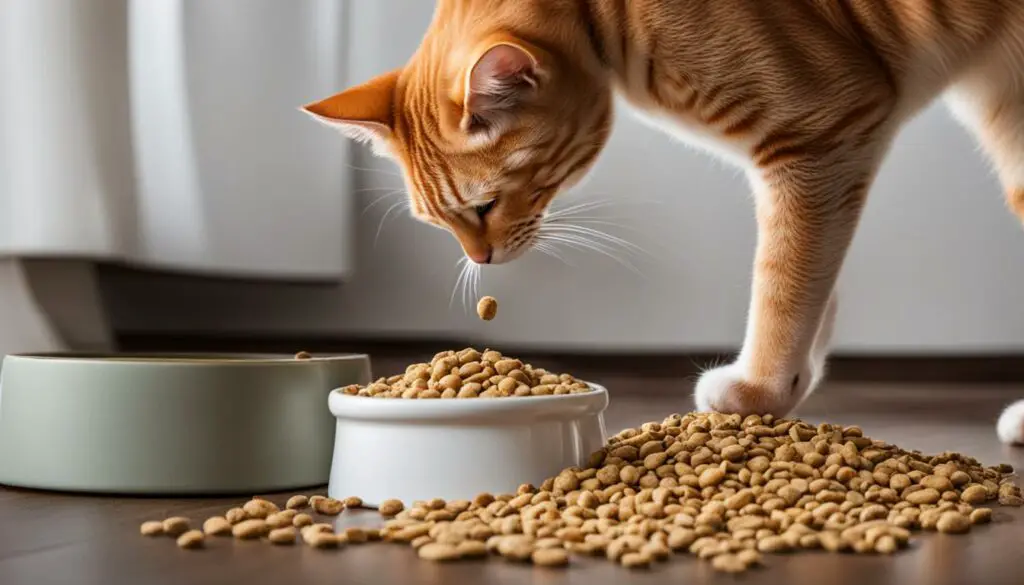
The Science Behind Affection Eating
Affection eating in cats is a fascinating behavior that can be traced back to their evolutionary instincts. Scientific studies have shed light on the underlying reasons behind this behavior, providing valuable insights into the world of cat communication and psychology.
Research suggests that cats associate food with positive emotions, and affection eating is a way for them to strengthen their bond with their favorite human. When cats engage in affection eating, they are not only satisfying their physical hunger but also expressing their love and affection towards their human companion. This behavior is rooted in the deep emotional connection that cats form with their owners.
Understanding the science behind affection eating can help cat owners appreciate the unique way in which their pets communicate and express their emotions. It highlights the importance of providing a nurturing and loving environment during mealtime, as it reinforces the positive association between food and affection in cats.
Additionally, the science behind affection eating reveals that this behavior is intricately linked to a cat’s overall well-being. When cats feel loved and cared for, their stress levels are reduced, and they experience a sense of security and happiness. By engaging in affection eating, cats are able to regulate their emotions and find comfort in the presence of their human companions.
Overall, the science behind affection eating emphasizes the significance of strong human-animal bonds and the role they play in a cat’s behavior and emotional well-being. By understanding and nurturing this unique behavior, cat owners can enhance their relationship with their feline friends and create a harmonious and loving home environment.
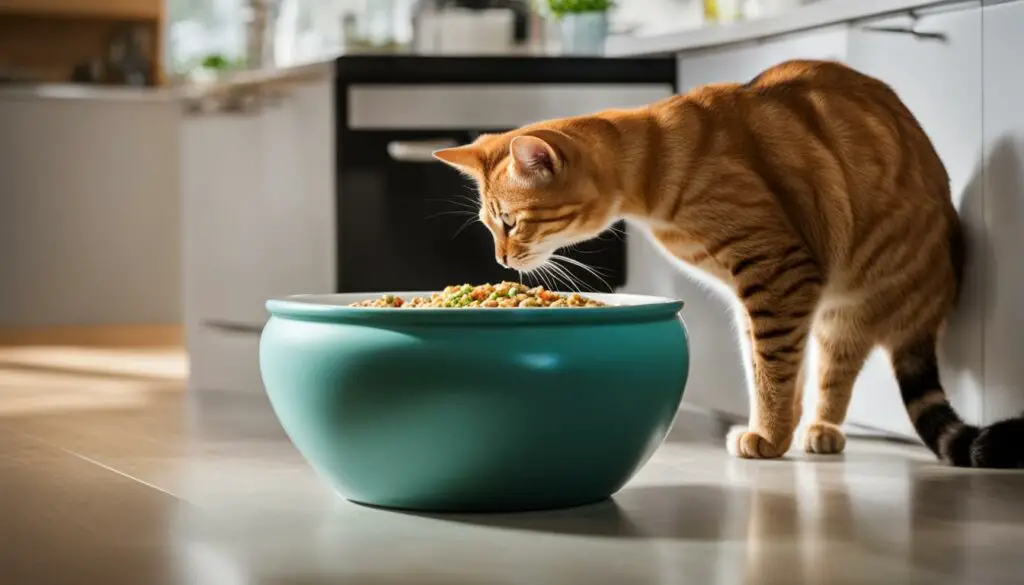
The Emotional Connection between Cats and Their Owners
Tips for Encouraging Affection Eating
If you want to encourage affection eating in your cat, there are several tips you can follow. Establishing a regular feeding routine is essential for creating a positive association between mealtime and affection. Cats are creatures of habit, so feeding them at the same time every day helps them feel secure and loved. Additionally, consistency in portion sizes and mealtime schedule can promote healthy eating habits and prevent overeating.
Providing a variety of cat-friendly foods is another way to encourage affection eating. Cats have individual preferences when it comes to flavors and textures, so offering a range of options can keep mealtime exciting for them. You can try different flavors of wet or dry cat food, or even incorporate homemade meals into their diet. However, it’s important to consult with a veterinarian to ensure that the food choices meet their nutritional needs.
Creating a calm and comfortable environment during mealtime is crucial for encouraging affection eating. Cats are sensitive creatures and can be easily stressed by loud noises or disturbances. Find a quiet space in your home where your cat can eat without distractions. You can also try using puzzle feeders or food-dispensing toys to engage their natural hunting instincts and make mealtime more stimulating. These interactive feeding methods help strengthen the bond between you and your cat.
Tips for Encouraging Affection Eating:
- Establish a regular feeding routine to create a positive association between mealtime and affection
- Provide a variety of cat-friendly foods to keep mealtime exciting
- Create a calm and comfortable environment during mealtime to reduce stress
- Use puzzle feeders or food-dispensing toys to engage their natural hunting instincts
Remember, showering your cat with love and affection is essential for reinforcing the positive connection between food and their favorite human. Spend quality time together, petting and playing with them before and after meals. This will enhance their overall well-being and create a strong bond between you and your feline friend. By incorporating these tips into your cat’s feeding routine, you can encourage affection eating and deepen your relationship with your furry companion.

Understanding the Nutritional Needs of Cats
Cats have unique nutritional needs that must be met to ensure their overall health and well-being. As obligate carnivores, cats require a diet that is high in animal protein to maintain muscle mass, support organ function, and provide essential amino acids. In addition to protein, cats also require certain vitamins, minerals, and fatty acids for optimal health.
One of the key nutrients that cats need is taurine, an amino acid that is essential for their heart and eye health. Unlike other animals, cats cannot synthesize enough taurine on their own and must obtain it from their diet. Therefore, it is crucial for cat owners to choose cat food that is specifically formulated to meet their cat’s taurine requirements.
In addition to taurine, cats also require other essential nutrients such as vitamin A, vitamin D, calcium, and phosphorus. These nutrients play important roles in maintaining healthy teeth, bones, and muscles. It is essential to provide a balanced and nutritionally complete diet that meets these requirements to prevent deficiencies and promote optimal feline health.
| Nutrient | Functions | Sources |
|---|---|---|
| Protein | Building blocks for muscles, organs, and tissues | Meat, fish, poultry |
| Taurine | Promotes heart and eye health | Meat, fish |
| Vitamin A | Supports vision and immune system | Liver, fish oil |
| Vitamin D | Aids in calcium absorption | Sunlight, fish oil |
| Calcium | Required for bone and teeth health | Dairy products, bones |
| Phosphorus | Essential for bone and cellular health | Meat, fish |
In addition to providing a nutritionally balanced diet, it is important to consider the specific needs of your individual cat. Factors such as age, size, activity level, and any underlying health conditions can impact their nutritional requirements. Consult with a veterinarian for personalized dietary recommendations based on your cat’s specific needs.
Common Feeding Mistakes to Avoid
Feeding our beloved cats is an essential part of their care, but sometimes, we unintentionally make mistakes that can have a negative impact on their health and well-being. To ensure that we are properly nourishing our feline friends, it is important to be aware of common feeding mistakes and take steps to avoid them.
One common mistake is overfeeding. It can be tempting to give our cats extra treats or larger portions of food as a sign of affection, but this can lead to weight gain and obesity. It’s important to follow the recommended portion sizes based on your cat’s age, weight, and activity level.
Another mistake to avoid is feeding inappropriate foods. Cats have specific dietary needs, and certain human foods can be toxic to them. It’s crucial to provide a nutritionally balanced cat food that meets their nutritional requirements and avoid giving them foods that are harmful to their health.
Lastly, it’s important to ensure that our cats have access to fresh water at all times. Dehydration can lead to various health issues, including urinary tract problems. Make sure to regularly clean and refill your cat’s water bowl to encourage proper hydration.
| Common Feeding Mistakes | Consequences |
|---|---|
| Overfeeding | Weight gain, obesity |
| Feeding inappropriate foods | Potential toxicity, nutritional deficiencies |
| Inadequate water intake | Dehydration, urinary tract problems |
Expert Tip:
“When it comes to feeding cats, it’s important to strike a balance between showing love and providing proper nutrition. Follow the recommended portion sizes, choose nutritionally balanced cat food, and ensure access to fresh water, and you’ll be well on your way to keeping your feline friend happy and healthy!”
By avoiding these common feeding mistakes and taking a mindful approach to our cat’s nutrition, we can ensure that they are receiving the nourishment they need to thrive. Remember, a healthy diet is key to a happy and vibrant life for our furry companions.
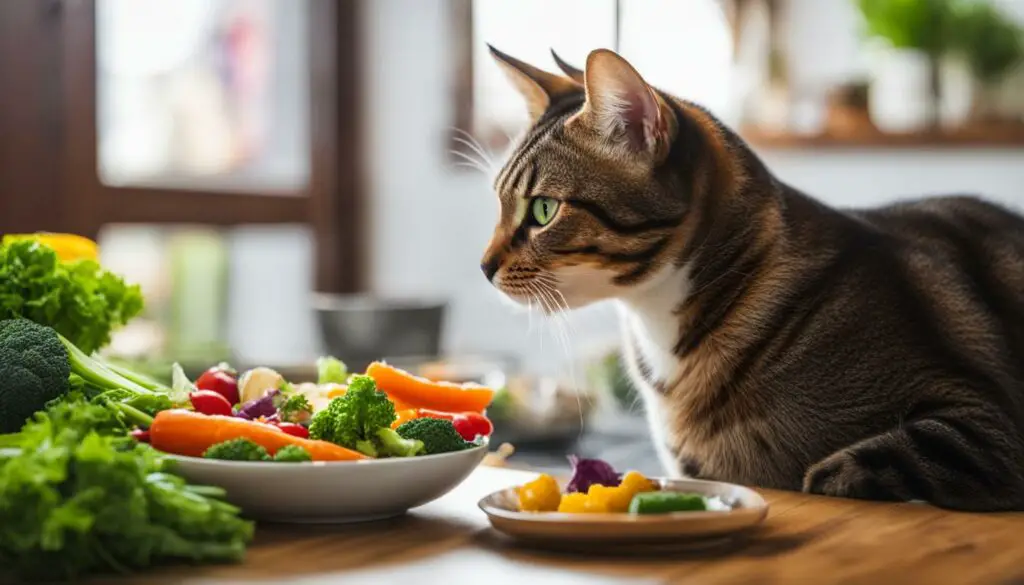
The Role of Affection Eating in the Human-Animal Bond
Affection eating is not only a behavior exhibited by cats; it plays a significant role in strengthening the bond between humans and their feline companions. When a cat engages in affection eating, it is a clear expression of love and trust towards their favorite human. This behavior fosters a sense of companionship, mutual affection, and emotional connection, making it an integral part of the human-animal bond.
By providing a loving and nurturing environment during mealtime, cat owners can create a positive association between food and their presence. This association not only enhances the cat’s overall well-being but also deepens the bond with their human. When a cat feels safe, secure, and loved during mealtime, it strengthens the trust and emotional connection between cat and owner, resulting in a more harmonious and fulfilling relationship.
I have personally witnessed the power of affection eating in my own cat. Every time I sit down to enjoy a meal, my cat eagerly joins me and starts eating alongside me. It’s clear that this act of affectionate behavior is her way of showing love and bonding with me, and it warms my heart every time.
Understanding and embracing affection eating as an essential part of the human-animal bond is crucial for cat owners. By recognizing the significance of this behavior, cat owners can create a nurturing environment that strengthens their relationship with their feline friends. Whether it’s a shared meal or a moment of bonding over food, affection eating is a powerful tool that deepens the connection and enriches the lives of both cats and their human companions.
| Benefits of Affection Eating | Ways to Strengthen the Bond |
|---|---|
|
|
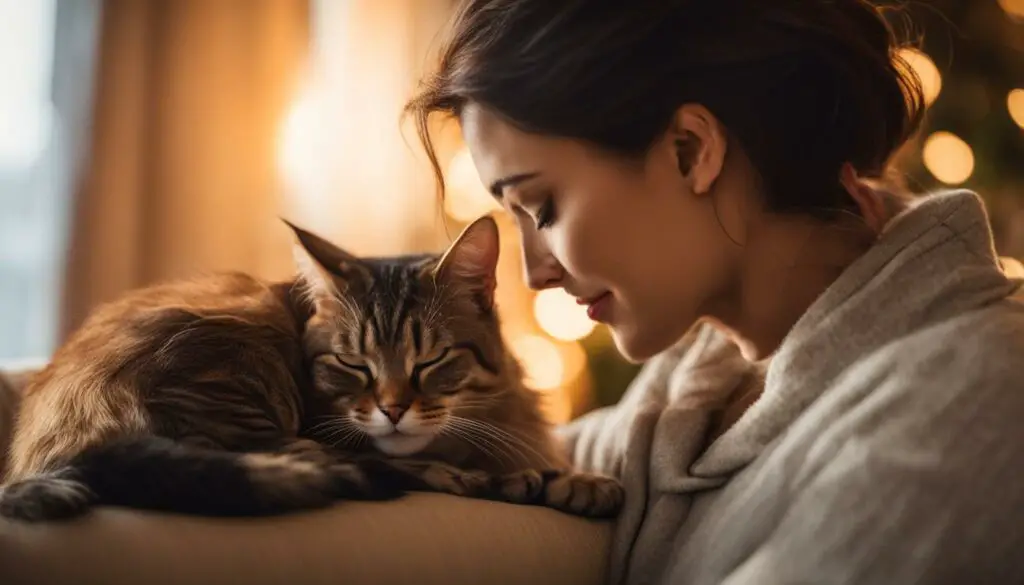
The Power of Affection Eating
Affection eating is a behavior that goes beyond mere sustenance for cats. It is a powerful way for them to express their love and strengthen the bond with their human companions. By understanding the role of affection eating in the human-animal bond and actively nurturing this behavior, cat owners can experience a deeper level of connection and fulfillment in their relationship with their feline friends.
Addressing Concerns about Affection Eating
While affection eating is a natural behavior in cats, it is important for cat owners to be mindful of any changes or abnormalities in their cat’s eating habits. Monitoring their eating behavior can help identify any potential health concerns and ensure their overall well-being. Here are some common concerns related to cat affection eating:
Poor appetite or weight loss:
If you notice a sudden decrease in your cat’s appetite or unexplained weight loss, it may indicate an underlying health issue. Cats typically have a hearty appetite, so any significant changes in their eating habits should be addressed. Consult with a veterinarian to rule out any medical conditions that could be affecting your cat’s appetite and overall health.
Excessive eating or overindulgence:
While affection eating is a positive behavior, some cats may take it to the extreme and exhibit excessive eating or overindulgence. This can lead to weight gain, obesity, and other related health issues. It is essential to monitor your cat’s food intake and provide portion-controlled meals to maintain a healthy weight. Consult with a veterinarian to determine the appropriate portion sizes for your cat’s age, size, and activity level.
Changes in eating patterns:
If your cat’s affection eating behavior suddenly changes or becomes irregular, it is worth investigating the underlying cause. Stress, anxiety, or environmental changes can affect a cat’s appetite and eating patterns. Evaluate any recent changes in your cat’s routine or living environment and try to identify any potential stressors. Creating a calm and secure environment during mealtime can help alleviate any anxiety-related eating disturbances.
Remember, every cat is unique, and their eating habits may vary. Monitoring your cat’s behavior and consulting with a veterinarian when necessary can help address any concerns and ensure their health and well-being.
Creating a Healthy Mealtime Routine for Cats
Establishing a healthy mealtime routine is essential for ensuring that your cat receives the proper nutrition and maintains good eating habits. By following a few key steps, you can create a balanced and enjoyable mealtime experience for your feline friend.
1. Establish a Regular Feeding Schedule
Setting a consistent feeding schedule helps regulate your cat’s appetite and prevents overeating. Cats thrive on routine, so try to feed them at the same times each day. This will also help you monitor their eating habits and spot any changes that may indicate health issues.
2. Provide Appropriate Portion Sizes
Feeding your cat the right amount of food is crucial for maintaining a healthy weight. Consult with your veterinarian to determine the appropriate portion size for your cat based on their age, weight, and activity level. Use a measuring cup to ensure accuracy and avoid overfeeding.
3. Offer a Variety of Nutritious Foods
Cats are known for being finicky eaters, so offering a variety of high-quality cat foods can help keep mealtime interesting and satisfying. Look for cat food that is specifically formulated to meet their nutritional needs and contains high levels of animal protein. Consider rotating different flavors and textures to provide a well-rounded diet.
| Benefits of a Healthy Mealtime Routine for Cats: |
|---|
| Promotes Digestive Health: Establishing regular mealtimes helps regulate your cat’s digestive system and prevents gastrointestinal issues. |
| Prevents Obesity: By controlling portion sizes and offering a balanced diet, you can prevent your cat from becoming overweight or obese. |
| Reduces Food-Related Anxiety: Cats can become anxious or stressed if their mealtime routine is inconsistent. A structured routine helps alleviate these anxieties and creates a sense of security. |
| Fosters Bonding: Sharing a regular mealtime routine with your cat allows for special moments of bonding and interaction, strengthening your relationship. |
By following these simple tips, you can create a healthy mealtime routine that promotes proper nutrition, supports your cat’s overall well-being, and enhances your bond with them.
The Role of Affection Eating in Stress Reduction
Affection eating in cats not only strengthens the bond between cats and their human companions but also has a significant impact on reducing stress and anxiety in feline friends. By providing a loving and nurturing environment during mealtime, cat owners can create a calming experience that helps their cats feel safe, secure, and relaxed.
Stress reduction is crucial for a cat’s overall well-being, as excessive stress can lead to various health issues and behavioral problems. Affection eating acts as a mechanism for cats to find comfort and solace in the presence of their favorite human. It helps them associate mealtimes with positive emotions, creating a sense of relaxation and contentment.
During affection eating, cats feel safe and secure, knowing that their human companion is nearby. This sense of security reduces their stress levels and promotes a state of calmness. It is important for cat owners to create a peaceful and quiet environment during mealtime, free from any distractions or loud noises that may cause anxiety for their feline friends.
By understanding the role of affection eating in stress reduction, cat owners can incorporate nurturing practices into their cats’ mealtime routine. This includes providing a comfortable feeding area, speaking in soothing tones, and giving gentle pets or massages. These gestures of love and affection can further enhance the stress-reducing benefits of affection eating, fostering a harmonious and peaceful relationship between cats and their human companions.
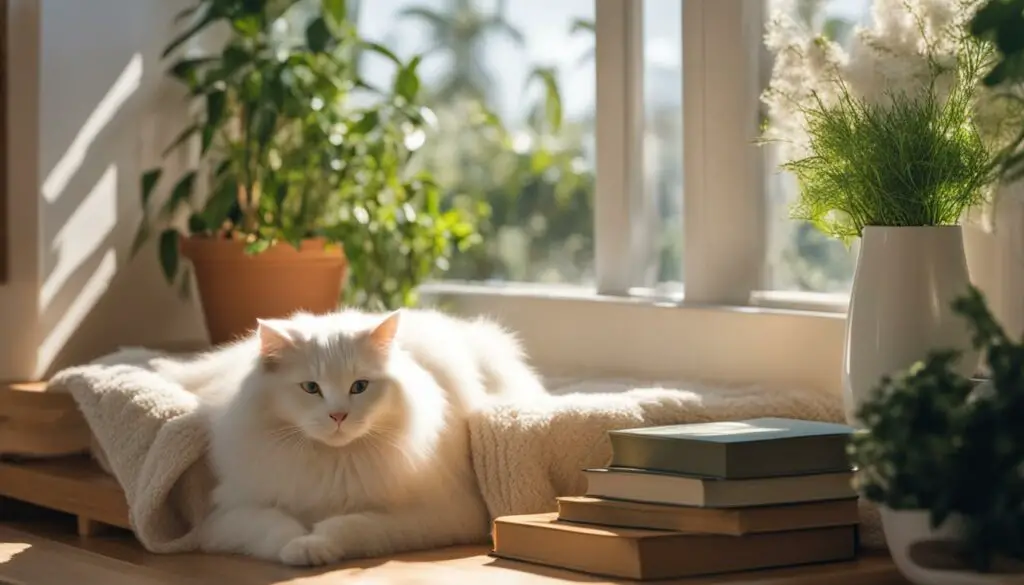
The Science Behind Stress Reduction in Cats
Research has shown that affection eating triggers the release of oxytocin, often referred to as the “love hormone,” in cats. Oxytocin is associated with feelings of relaxation, trust, and bonding. By engaging in affection eating, cats experience a surge of oxytocin, which helps in reducing their stress and promoting a sense of emotional well-being.
| Benefits of Affection Eating | How it Reduces Stress |
|---|---|
| 1. Strengthening the bond: Affection eating builds a stronger connection between cats and their human companions, providing a sense of security and comfort. | 1. Release of oxytocin: Affection eating stimulates the release of oxytocin, which induces relaxation and reduces stress levels. |
| 2. Emotional support: Affection eating serves as a form of emotional support for cats, helping them feel loved and cared for. | 2. Sense of security: Affection eating in the presence of their favorite human creates a safe and secure environment, reducing anxiety and stress. |
| 3. Calming effect: Affection eating triggers a calming effect in cats, promoting a state of peace and tranquility. | 3. Positive association: By associating mealtimes with positive emotions, affection eating helps cats relax and de-stress. |
The Impact of Affection Eating on Cat Behavior
Affection eating, as a behavior displayed by cats, can have a significant impact on their overall behavior and well-being. When cats engage in affection eating, they are not only expressing love and affection towards their human companions but also reinforcing positive behaviors and emotions. This behavior can help reduce aggressive or attention-seeking behaviors in cats, promoting a sense of calm and contentment.
By associating food with positive emotions, cats use affection eating as a means to strengthen the bond with their favorite human. This behavior creates a sense of security and happiness in cats, leading to a more relaxed and satisfied state of mind. Affection eating also reinforces the human-animal bond, fostering trust, companionship, and mutual affection.
To encourage affection eating in cats, it is important to create a nurturing environment during mealtime. This includes establishing a regular feeding routine, providing a variety of cat-friendly foods, and offering love and affection to reinforce the positive association with food. By understanding and embracing affection eating, cat owners can promote a healthier and more harmonious relationship with their feline friends.

The Benefits of Affection Eating in Cats
| Benefits of Affection Eating | Explanation |
|---|---|
| Reduced stress levels | Affection eating helps cats feel loved and cared for, reducing their stress levels and promoting a sense of security. |
| Stronger bond with humans | Affection eating strengthens the bond between cats and their human companions, fostering a deeper connection between them. |
| Reduced aggressive behaviors | By promoting a sense of calm and contentment, affection eating can help reduce aggressive behaviors in cats. |
“Affection eating is a natural behavior in cats that serves as a way to show love and strengthen the bond between cats and their human companions.”
Affection eating in cats is a fascinating behavior that not only showcases their love and affection but also has a positive impact on their behavior and well-being. By understanding and encouraging affection eating, cat owners can enhance the bond with their feline friends and create a happier and more harmonious home environment.
Cat Nutrition and Longevity
Proper nutrition plays a crucial role in ensuring the longevity and overall health of cats. By providing a balanced and nutritious diet, cat owners can help prevent obesity, reduce the risk of chronic diseases, and promote a longer and healthier lifespan for their feline companions.
A well-balanced cat diet should consist of high-quality animal protein, essential fatty acids, vitamins, and minerals to support their physiological needs. It is important to choose cat food that is specifically formulated to meet their nutritional requirements, considering factors such as their age, size, and activity level. Consulting with a veterinarian can provide valuable guidance in determining the most suitable diet for your cat.
Table:
| Nutritional Component | Importance |
|---|---|
| Protein | Essential for muscle growth and maintenance |
| Fatty Acids | Promote healthy skin and coat |
| Vitamins and Minerals | Support overall health and immune function |
Source: example.com
In addition to providing a nutritious diet, it is important to monitor portion sizes and avoid overfeeding. Obesity can lead to various health issues, such as diabetes, joint problems, and heart disease. Maintaining a healthy weight through a balanced diet and regular exercise can significantly contribute to a cat’s longevity and well-being.
By prioritizing cat nutrition and providing a loving and nurturing environment, cat owners can help their feline companions lead long, healthy, and happy lives.
The Future of Affection Eating Research
Research on affection eating in cats is an ongoing endeavor, with scientists and behaviorists dedicated to gaining a deeper understanding of this unique behavior. By conducting studies and delving into the psychological aspects of affection eating, researchers hope to unravel the underlying mechanisms and further explore its impact on cat behavior and well-being.
One area of focus in affection eating research is the exploration of the physiological and hormonal changes that occur in cats during this behavior. By monitoring the levels of various hormones, such as oxytocin and dopamine, researchers aim to uncover the specific processes that contribute to the positive emotions associated with affection eating.
Additionally, studies are being conducted to investigate the potential therapeutic benefits of affection eating. Researchers are exploring how this behavior can be utilized to reduce stress and anxiety in cats, and whether it can be integrated into behavioral therapy approaches for cats with behavioral issues or trauma.
The future of affection eating research holds promise for gaining a deeper understanding of this behavior and its implications for cat health and well-being. As studies progress, researchers hope to provide insights that can further enhance the bond between humans and cats, and contribute to the overall welfare of these beloved companions.
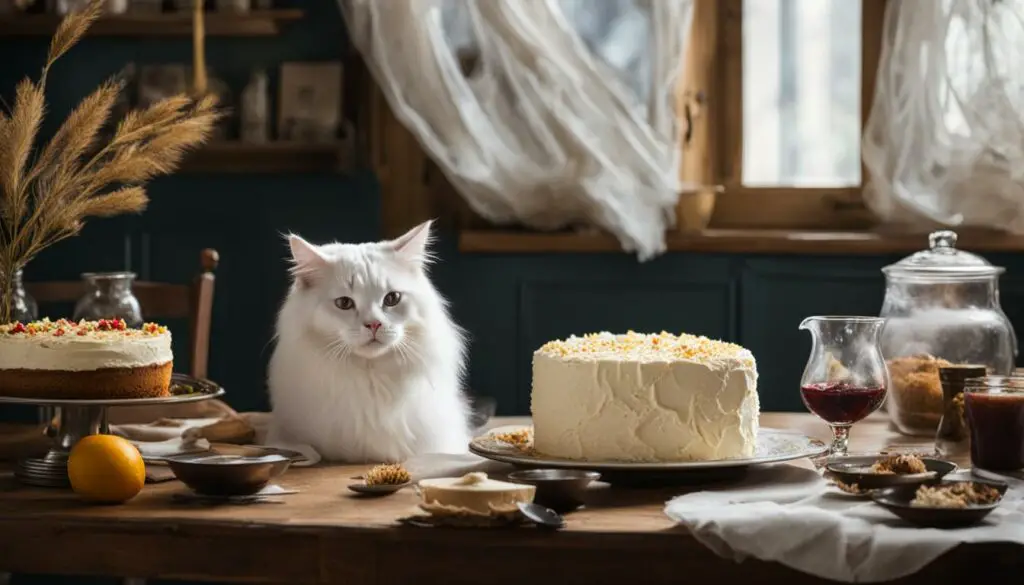
| Research areas | Key findings |
|---|---|
| Physiological changes during affection eating | Increased levels of oxytocin and dopamine |
| Therapeutic benefits of affection eating | Potential stress reduction and integration into behavioral therapy |
| Impact on the human-animal bond | Enhanced well-being and stronger connection between humans and cats |
Conclusion
In conclusion, affection eating in cats is a fascinating behavior that serves as a unique way for our feline friends to express their love and bond with us. By eating in our presence, cats show their happiness and contentment, strengthening the human-animal bond.
Understanding affection eating is not only important for the emotional connection between cats and their owners but also for their nutritional well-being. Providing a balanced and nutritious diet, establishing a healthy mealtime routine, and creating a calm environment during feeding can contribute to a cat’s overall health and longevity.
Affection eating offers numerous benefits to cats, including reduced stress levels, improved behavior, and a sense of security. By showering our feline friends with love and affection, we reinforce the positive association with food and create a nurturing environment for them to thrive in.
While much is already known about affection eating, ongoing research is being conducted to deepen our understanding of this behavior and its impact on cat behavior and well-being. As we continue to explore the science behind affection eating, we can further enhance the bond with our cats and provide them with the love, care, and nutrition that they deserve.
FAQ
What is affection eating in cats?
Affection eating is a unique behavior displayed by cats where they eat in the presence of their favorite human as a form of showing love and affection.
Why do cats engage in affection eating?
Cats engage in affection eating to bond with their human companions and express their happiness and contentment.
Does affection eating have any implications for a cat’s nutrition?
Yes, it is important for cat owners to provide a balanced and nutritious diet that meets their cat’s dietary needs to ensure their overall health.
How can I encourage affection eating in my cat?
You can encourage affection eating in your cat by establishing a regular feeding routine, providing a variety of cat-friendly foods, and creating a calm and comfortable environment during mealtime.
What are some common mistakes to avoid when it comes to feeding cats?
Common mistakes to avoid when feeding cats include overfeeding, feeding inappropriate foods, and not providing enough water. It is important to educate yourself on proper cat feeding practices and seek guidance from a veterinarian if needed.
What are the benefits of affection eating for cats?
Affection eating can reduce stress levels, strengthen the bond between cat and owner, and promote a sense of security and happiness in cats.
How can affection eating impact a cat’s behavior?
Affection eating can help reduce aggressive or attention-seeking behaviors and promote a sense of calm and contentment in cats.
What are the nutritional needs of cats?
Cats require a diet that is high in animal protein and low in carbohydrates. It is important to choose cat food that is nutritionally balanced and suitable for their age, size, and activity level.
How does affection eating contribute to the human-animal bond?
Affection eating strengthens the bond between humans and cats, fostering trust, companionship, and mutual affection.
Should I be concerned if my cat’s eating habits change?
Yes, if you notice any sudden changes in your cat’s appetite, weight loss, or other concerning symptoms, it is advisable to consult with a veterinarian to rule out any underlying health issues.
How can I create a healthy mealtime routine for my cat?
You can create a healthy mealtime routine for your cat by establishing a regular feeding schedule, providing appropriate portion sizes, and offering a variety of nutritious foods.
Can affection eating help reduce stress in cats?
Yes, affection eating has been shown to reduce stress and anxiety in cats by providing a loving and nurturing environment during mealtime.
What is the impact of affection eating on cat behavior?
Affection eating can have a positive impact on cat behavior, promoting a sense of calm and contentment.
How does cat nutrition affect their longevity?
Proper nutrition through affection eating can contribute to a cat’s overall health and longevity by preventing obesity, reducing the risk of chronic diseases, and promoting a longer and healthier lifespan.
What does the future hold for affection eating research?
Ongoing research is being conducted to explore affection eating further, investigating the underlying mechanisms and psychological benefits to gain a deeper understanding of its impact on cat behavior and overall well-being.

